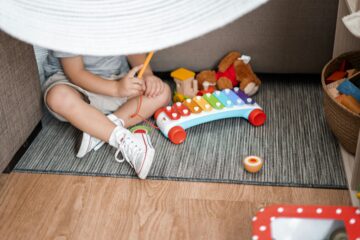The history of children’s toys is a journey from simplicity to complexity. Traditional toys like wooden blocks, dolls, and puzzles have long been cherished for their simplicity and developmental benefits. With the advent of technology, high-tech toys have emerged, symbolising modern childhood with their interactive and programmable features. Traditional toys are those that do not rely on technology. They include items like blocks, puzzles, dolls, board games, and outdoor play equipment.
The growth and evolution of any concept or product are known to have started at a simple level and while moving or growing it reaches a much more complex stage, eg. the wheel, was simply created to reduce the load and simplify the process of moving goods from one place to another. However, the wheel is made for various different reasons and there are many different types of wheels.
Similarly, the history of children’s toys is a journey that started out for a simple reason which was to entertain children and has moved towards using this concept of entertainment to help with various developments of kids, making the growth of toys a bit complex in nature. The simplicity of a traditional toy has been long cherished for its developmental benefits whereas the nature of high-tech toys has emerged from traditional toys while also symbolizing modern childhood. Traditional toys are built independently and creatively with items like building blocks, puzzles, dolls, board games and outdoor play equipment.
On the other hand, technologically enabled toys contain electronic components and are often used to interact with children through lights, sounds and other multimedia features. While traditional toys are built on an independent foundation, tech toys are a more advanced and creative version of traditional toys that are especially beneficial towards learning and accessibility. Some of these toys include educational apps, programmable robots, interactive storybooks and electronic learning toys.
Positive Impacts
| Traditional Toys | Tech Toys |
| Developmental Benefits Traditional toys are essential for child development as they help children engage in physical activities and are also important in developing fine motor skills. For eg. Assembling puzzles enhances hand-eye coordination. | Educational Engagement Tech toys can make learning fun and interactive. Educational apps and games can teach subjects like math, science, and language arts in engaging ways.Tech Toys or digital educational devices can make learning a more fun and interactive experience. |
| Imaginative Play Children often use their imagination to play with these toys. A stick can become a sword, a wand or a tool, depending on what the child makes of it. Imaginative play is extremely important for cognitive and emotional development. | Adaptability to Individual Learning Styles Many neurodiverse children require a more tailored or customised fitting that can help their learning needs. Technological toys or learning devices easily pick up on individual learning styles and provide information in the necessary style. |
| Social Interaction Games like board games, card games, etc. all fall under traditional games. These types of games almost always boost social interaction and teach children valuable social skills like sharing, cooperation and how to resolve a conflict. | Building Technological Awareness Learning and familiarising with technology or even tech-based toys can help children develop essential skills from an early age. This will help them prepare for a more tech-savvy modern future. |
| Reduced Screen Time Playing with traditional toys can reduce the amount of time a child spends on screen and promotes a healthier balance in their day-to-day activities. | Entertainment Digital or tech toys offer many forms of entertainment which help keep children engaged for hours. From interactive storybooks to games and more. |
| Emotional Intelligence Development Traditional toys are known to increase emotional intelligence in children. Playing with dolls, role-playing etc. all help children understand and express emotions. | Accessibility Accessibility is an important feature that has to be implemented in all technological products. This helps children with different abilities and needs to use the gadget or product with more ease. |
Balancing Traditional and Tech Toys
Individually these categories are extremely vital towards children’s overall development, however together it is more important to strike a balance between combining them. Combining them can create a well-rounded play experience while also allowing children to explore all aspects of playtime.
While screen time is essential, parents should be aware that they need to limit screen time to ensure children are not overly reliant on tech toys. While lying down clear rules of when and how long children can use their tech-driven toys help maintain a good healthy balance.
A regular schedule of Family Game Night includes a mix of traditional board games, card games and interactive digital games. These practices tend to strengthen familial bonds while also allowing for a seamless blend of good old-fashioned and modern entertainment. You can use digital games such as online ludo which is traditional yet digital as they foster social interaction.
It is critically vital as well while incorporating and understanding the various kinds of toys, to understand and further encourage your child’s interest. It is also important to help balance their interests in both aspects of toys to help develop all skills while also preparing them for future technological experiences.
The history of children’s toys has evolved from simple, traditional toys like wooden blocks and dolls to complex, high-tech gadgets. Traditional toys foster physical activity, fine motor skills, and imaginative play, while tech toys enhance learning through interactive features and cater to diverse learning styles.
Both traditional and tech toys are essential for children’s balanced development. Traditional toys promote social interaction and emotional intelligence, while tech toys offer tailored educational experiences and accessibility. A balanced approach, combining both types of toys, provides a comprehensive play experience that supports overall development and prepares children for a tech-savvy future.
For more insights on the balance between high-tech and traditional toys, check out these resources:
High-Tech or Traditional Toys: Which Are Better for Children?



0 Comments